Ratatouille
- rosemarydearman1
- Apr 10, 2019
- 8 min read
"the true taste of Provence" Robert Carrier

I almost didn't go through with this blog when I realised what my former post had been - Sicilian sweet and sour - for in a way this very Provençal dish is very similar to some of the dishes I wrote about there. But it is different and so I am persevering.
It came up in the current book group book in which one of the characters says he won't cook ratatouille because it has been 'demeaned by the tourist industry' - and he cooks bohémienne instead (more about that either later in this post or another time). I was a bit enraged by this statement because I actually think you can get pretty good ratatouille in restaurants in France. On the one hand you get people moaning about 'authentic' dishes disappearing from menus - the globalisation of food I guess - and on the other you get people moaning about bad quality bouillabaisse, ratatouille and the like. You just can't win it seems to me when you start talking about tourism and food.
I first tasted ratatouille - not in Provence but in Grenoble, where I worked as an au pair in the summer holidays before my last year at university. The lady of the house, was not really into cooking but she did like to cook ratatouille. I had never had it and I have to say at first I was not enamoured. But I persevered and eventually came to love it. She always served it with rice and always forgot to add any salt - well I don't add salt to anything I cook these days - I just add it at the table. This same family spent some of that summer in the Jura at the family mansion where there was an amazing Provençale cook, Madame Perruque, who I'm sure I have written about before. But you know I cannot remember her cooking ratatouille, although I'm pretty sure she would have done. And I bet she would have put black olives into it too. She put black olives in everything. Well almost. She was a most superb cook and I didn't write anything of what she did down, even though I would often be in the kitchen when she was preparing the meals.
Anyway I chose the picture at the top of the page because this is how I remember my 'boss' Madame Droulers' ratatouille looking. A melange (mixture) that is not quite a complete mixture. For this is the danger when cooking ratatouille - ending up with a homogenous watery mash. For:
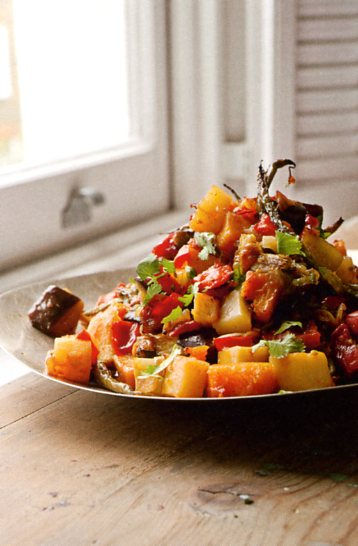
"A great ratatouille is one in which the vegetables interact with each other, but are still discernible from each other." Yotam Ottolenghi
Ottolenghi himself doesn't really have a recipe for ratatouille as far as I can see. He has an Indian version and also the version shown at left which is called Tamara's ratatouille because it is from a friend - Tamara Meitlis. It is also not at all 'authentic' as it includes all sorts of other vegetables - squash, parsnip, green beans, potato. I have only included it to show how the texture should be - well according to one viewpoint.
You might think that because everyone goes on about it being such a Provençal thing, that it is an ancient dish. Well it probably is. I bet that people have been cooking this particular mix of vegetables - eggplant, zucchini, peppers, onions, tomatoes with the inevitable olive oil and garlic, for centuries. I mean how would they not? It's such an obvious mixture and such a peasant kind of idea - to stew things together. Most peasants probably only had one pot, so I expect most dishes were all cooked in one pot. None of this cooking each vegetable separately in a separate pan. However the word ratatouille which comes from a Provençal word 'touiller' meaning to mix, was only written down in the late 19th century according to some, the 17th according to others. But the first recipe didn't appear until the 1930s. So it's not very ancient or 'authentic' at all. Indeed it might just be another cheffy invention that took off.
Felicity Cloake does her best to disentangle it all by making the 'perfect ratatouille' and she does give some useful pointers and explains the major controversy with ratatouille - do you cook each ingredient separately, just combining them at the end, or cook them all together?
"there is some debate about whether the constituent parts should be cooked together, or separately. Larousse Gastronomique notes that "according to the purists, the different vegetables should be cooked separately, then combined and cooked slowly together until they attain a smooth, creamy consistency." It then, with characteristic Gallic insouciance, goes on to give a recipe in which everything is lumped in together and pedants be damned." Felicity Cloake
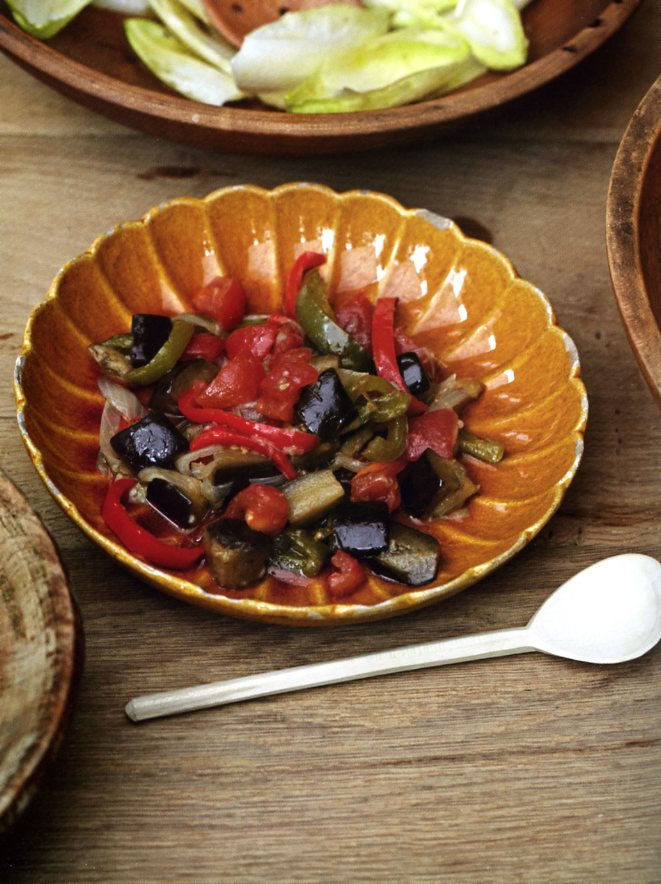
Well I have now checked out several recipes from various gurus and have come to the conclusion that the majority favour a sort of half and half approach, in which you cook the eggplants and onions first, add the peppers, then later the zucchini and finally the tomatoes. And of course, there's always the controversy about whether you salt the eggplant and zucchini first to get rid of bitter juices, or not. And do you go for slices or chunks? Elizabeth David, does not even include the zucchini. Her version is shown here, and I have to say it looks a tiny bit stingy really. Though she does add coriander - seeds that is - which is another controversy. Some do, some don't. Having looked them all over I think I am going to offer Beverley Sutherland Smith's as the one closest to my approach when I make it. It's very similar to Delia's version - just takes slightly longer and has more herbs. That's Delia's version below.
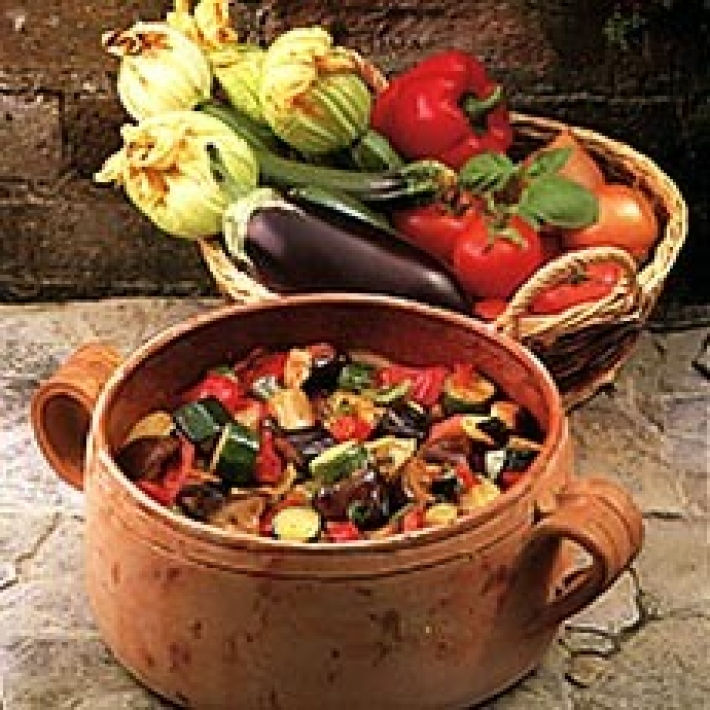
RATATOUILLE NIÇOISE
2 eggplants about 500g cut into 1.3cm slices
salt
1/2 cup olive oil
2 onions, halved and thinly sliced
375g zucchini, thickly sliced
1 red capsicum, deseeded and cut into strips
1 green capsicum, deseeded and cut into strips
600g tomatoes, peeled and roughly chopped
1 teaspoon sugar
3 cloves garlic, roughly chopped
1 teaspoon freshly chopped thyme
1 tablespoon freshly chopped basil
1/2 teaspoon ground coriander
1/4 cup finely chopped parsley
freshly ground black peppe
extra fresh parsley, finely chopped
Put the eggplant on to a tray or plate and scatter with salt. Leave to stand for 30 minutes and then rinse. Drain well on kitchen paper towel.
Gently heat half the oil in a large saucepan. Add the onion and cook until soft and golden. Remove the onion to a bowl. Add the remaining oil to the saucepan and turn up the heat. Cook the eggplant, stirring, for about 5 minutes or until tinged with gold, then add the zucchini, capsicum, tomato and sugar. Scatter on the garlic and herbs, stir gently, check seasoning and cover the saucepan. Cook over a very low heat for about 45 minutes or until the vegetables are tender, stirring once or twice. Watch carefully - if left too long the vegetables will become soft and the dish watery. If there is too much liquid after 30 minutes, remove the lid and leave to cook uncovered. To serve, transfer to a large bowl and scatter the top with parsley.
"Ratatouille requires ripe vegetables, a liberal hand with the olive oil, and patience: only long, slow cooking will give you the creamy soft vegetables, and intense, almost jammy sauce that sings of the sun. Anything else is just plain vegetable stew." Felicity Cloake
Well in his book, Feasts of Provence, Robert Carrier gives a recipe for 'instant ratatouille/ratatouille minute'. The preparation of the vegetables might take a bit of time - you have to slice them up quite finely and also roast the garlic, but the cooking takes 5 minutes! Now I might try that. No picture I'm afraid. He says it will serve four.
RATATOUILLE MINUTE
6 cloves garlic, extra virgin olive oil
1/2 green pepper
1/2 red pepper
1/4 yellow pepper 1 small eggplant
1 zucchini
1 large tomato
coarse salt and cracked black pepper
8 small lettuce leaves (from the heart)
lemon juice
Place the garlic cloves on a piece of aluminium foil, brush the foil with olive oil, crimp it round the edges to make a sealed packet and bake in a pre-heated oven for 10 minutes.
Cut the tops and bottoms off the pepper halves and cut each one into 15-20 thin matchsticks. Save the tops and bottoms to use finely diced as a garnish for a salad dressing. Cut segments of eggplant and zucchini the same length as the pepper sticks, then cut each segment into thin strips. Cut the top and bottom off the tomatoes, cut the central segment into thin slices and then cut each slice into thin strips.
Season the prepared vegetable strips with coarse salt and cracked pepper and fry in very hot oil for 5-6 minutes. Drain.
To serve - Fold the small lettuce leaves and basil leaves into the fried vegetable sticks, add a squeeze of lemon juice and serve immediately.
Interesting - and unique - I didn't see anything else like this. Nor like his own ratatouille which is less cooked than most:

MY RATATOUILLE
8 tablespoons olive oil
2 Spanish onions, sliced
2 green peppers, diced
2 eggplants, diced
2 zucchini, cut in 12mm slices
4-6 ripe tomatoes, peeled, seeded and cut into wedges
salt and ground black pepper
1 tablespoon chopped parsley
1 pinch marjoram or oregano
1 pinch basil
1 large clove garlic, crushed
Heat 2 tablespoons of olive oil in a frying pan, add the onions and green peppers and sauté until the onions are transparent. Lower the heat and continue to cook the vegetables for 5 more minutes, stirring from time to time. Transfer the vegetables to a large bowl.
Heat 2 more tablespoons olive oil in the pan, add the garlic, and eggplant and sauté, stirring from time to time, until the eggplants are lightly browned. Lower the heat and continue to cook for 5 minutes. Season as above. Transfer to the bowl.
Heat 2 more tablespoons olive oil in the pan, add the zucchini and cook, stirring from time to time, for 5 minutes, add the tomato wedges and cook for 3 more minutes or until the vegetables begin to soften. Season as above and add to the bowl.
When ready to serve combine the vegetables in a heat-proof casserole and heat through. Correct the seasoning. Sprinkle with chopped basil and parsley and serve immediately.
These are the more traditional approaches, albeit varied here and there. The most extreme variation I saw was Shannon Bennett's because he added ham and anchovies. But then again, why not? And if you really want to be complicated - well there's always Heston Blumenthal. A labour of love that may or may not be worth it.

Going back to Felicity Cloake though and her pursuit of the perfect ratatouille. If you look in 'Google Images' for pictures of ratatouille you will be confronted by many similar pictures to the one on the left. This is all down to that rather wonderful kids film Ratatouille about a rat who became a chef and made the perfect ratatouille that looked a bit like this. It was apparently devised by Thomas Keller for the film. And Interestingly this is the approach that Felicity Cloake takes producing something that looks a bit chunkier but similar.
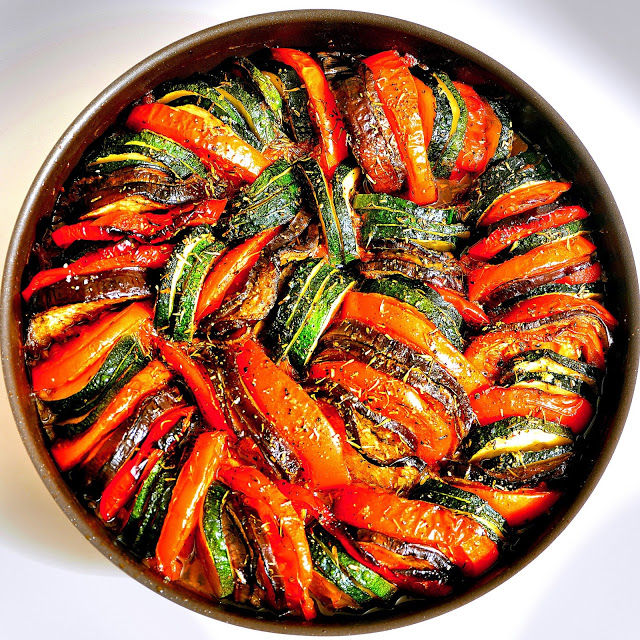
Or as put on a plate by somebody else -

Very fancy.
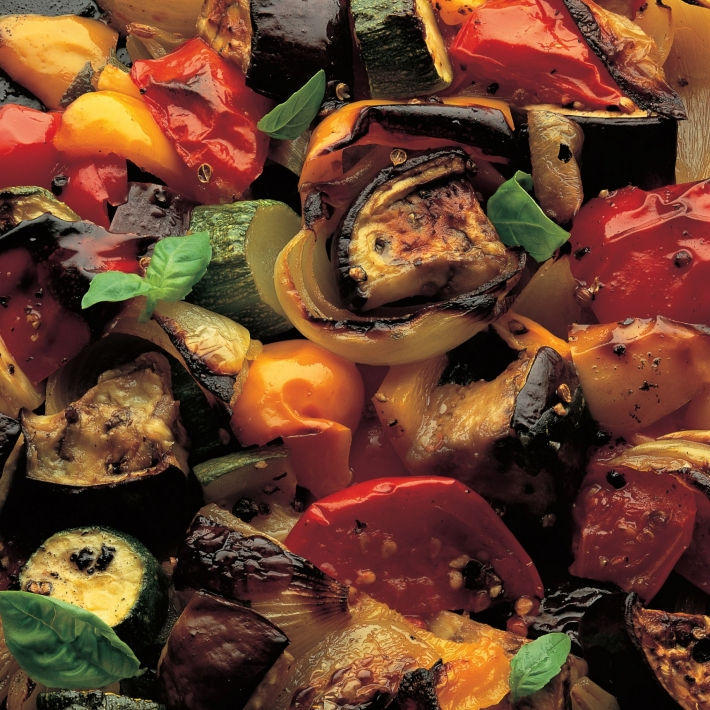
I can't leave the subject of ratatouille without a mention of Delia's roasted ratatouille, which has become a bit of a staple in this house. In this version you simply roast all the veggies together in the oven. The same method applies to any other vegetables as well. I don't know whether she thought of it first or not, but it is apparently one of her most popular dishes. And it is the roasted versions which seem to dominate the modern cooking scene these days. For you can do so much with them.
"I often make leftover ratatouille into a savoury pie. A crumble top of flour, butter, thyme leaves and grated cheese forms a suitable contrast to the soft ingredients underneath. I also like it cold, as a salad. So versatile is this mélange of summer ingredients that it often ends up as a pasta sauce, working well with larger, tube-shaped pastas. I have also seen it cooked in tiny metal moulds and turned out to form a neat mound on the plate with a surrounding drizzle of tomato sauce and perfectly positioned basil leaves. In which case it might be better called rata-twee." Nigel Slater
I have also used it to roast sausages with, in a quiche, and in an open form tart. The possibilities are almost endless.
So there you go - and ancient peasant dish that isn't really and which is still evolving.












Comments